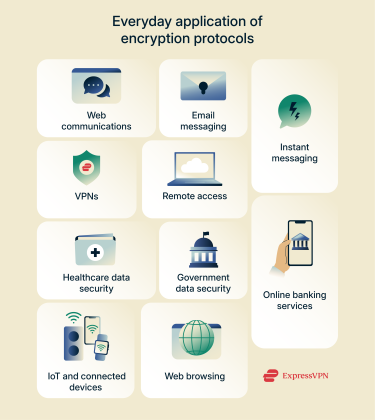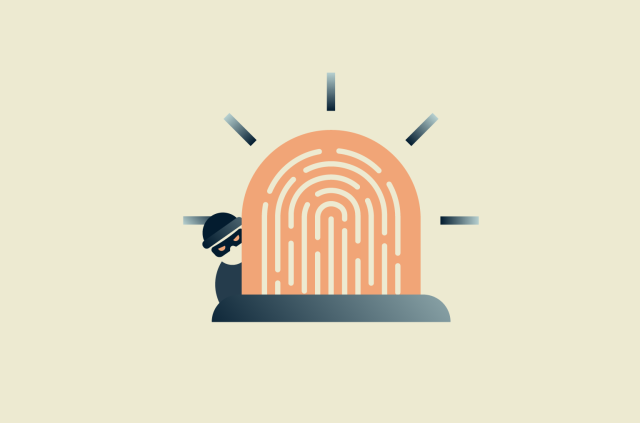Encryption protocols explained: What they are and how they work

Picture sending an important letter without an envelope. Anyone along the way could read it. That’s essentially what happens when your data travels online without protection. Encryption protocols solve this problem by locking your information in a secure, coded format that only the intended recipient can unlock.
In this article, we’ll explain clearly what encryption protocols are, why they’re essential to modern security, and how they work.
What is an encryption protocol, and why does it matter?
An encryption protocol is a set of rules that uses one or more encryption algorithms to perform a specific security function. While the protocol defines how and when encryption is applied, the algorithm is the actual method that transforms readable data (plaintext) into an unreadable format (ciphertext) using a cryptographic key. Without the correct key, that ciphertext can’t be turned back into its original form.
Commonly used encryption algorithms include:
- Advanced Encryption Standard (AES): A symmetric algorithm that supports 128-bit, 192-bit, and 256-bit keys and is trusted by the U.S. government for securing classified information.
- Rivest-Shamir-Adleman (RSA): A widely used asymmetric algorithm whose security depends on the difficulty of factoring very large prime numbers.
Encryption protocols typically combine multiple algorithms, each with a specific role. A protocol might use an asymmetric algorithm like RSA to exchange keys securely, then switch to a symmetric algorithm like AES to encrypt the actual data. Examples include a TLS/SSL protocol for safe web browsing, SSH for secure remote access, and IPsec for encrypted network traffic.
Learn more: Read about the encryption history, evolving from ancient cryptographic tools to the advanced schemes used today.
How do encryption protocols work?
The way an encryption protocol works depends on its purpose and the algorithms it uses. Most rely on either symmetric or asymmetric encryption (or a mix of both) to protect data.
Symmetric vs. asymmetric encryption
In symmetric encryption, the same key is used for both encrypting and decrypting data. This makes it fast and efficient, which is great for handling large amounts of information or real-time communication. The drawback is that both sides need access to the key, and securely sharing it can be tricky. If the key is intercepted, the encryption can be broken.
Asymmetric encryption avoids that problem by using two keys instead of one: a public key, which can be shared openly, and a private key, which must be kept secret. Data encrypted with the public key can only be decrypted with the matching private key. This makes it more secure for exchanging keys and verifying identities, but it is slower and requires more processing power.
| Symmetric | Asymmetric | |
| Security | Strong | Strongest for key exchange |
| Speed | Faster | Slower |
| Keys | 1 shared key | 2 keys (public and private) |
| Processing power | Lower | Higher |
| Best for | Efficiency | Secure key distribution |
Hybrid encryption
Hybrid encryption combines the strengths of both symmetric and asymmetric methods to balance speed and security. Here’s how it usually works:
- Both parties create their own public and private keys.
- Depending on the encryption suite in use:
- They may negotiate a shared symmetric key together (using a method like Diffie-Hellman).
- One party may generate a symmetric key and send it, encrypted with the recipient’s public key.
- Once both sides have the same symmetric key, all future communication is encrypted and decrypted with it, making data exchange both secure and efficient.
The role of cryptographic keys
A cryptographic key is a special piece of information that the encryption algorithm uses to know exactly how to scramble (encrypt) your data and also how to unscramble (decrypt) it. It’s the secret ingredient that makes the process work.
Let’s see this in action using a safe, client-side tool like CyberChef (developed by GCHQ, the U.K.’s cybersecurity agency). Because everything runs inside your browser, nothing you type is ever sent to a server. Here’s how it works:
- Open CyberChef. You will see three main panels: Input, Recipe, and Output. The operations list is on the right.
- In the Input panel, enter a plaintext, for example, “ExpressVPN.”
- In the Operations list, search for AES Encrypt and drag it into the Recipe panel.
- Set the key and its format. In the AES Encrypt settings, click the small dropdown next to Key and choose UTF-8. Enter a demo key with a valid AES length, for example, “JustForKicks1234”:
- 16 characters = 16 bytes = AES-128
- 24 characters = 24 bytes = AES-192
- 32 characters = 32 bytes = AES-256
- Set Mode to ECB for this simple demo. ECB doesn’t use an IV, so leave the IV field empty. Note for later: ECB is fine for a demo but not recommended for real data because it’s the simplest mode of AES. Use CBC or GCM with a random IV in practice.
- Click Bake. The Output panel shows ciphertext. For these exact settings you may see something like dc8f2da22d912804910aa148ef147d88.

Once you’ve encrypted your message, you can prove it works by adding an AES Decrypt step with the same key and settings. The ciphertext will instantly turn back into your original text, showing that only the correct key can unlock it.
Handshake and session initiation
In encryption protocols like TLS/SSL, a handshake is the process that sets up a secure session between two parties. It serves several purposes:
- Introducing the two sides to each other.
- Verifying their identities.
- Agreeing on which cryptographic algorithms to use.
- Generating the session keys that will protect their communication.
Here’s how it works in practice:
- Alice (the client) reaches out to Bob (the server) to start communication.
- Bob replies with authentication data, which includes his digital certificate and the list of encryption algorithms (cipher suite) he supports.
- Alice checks Bob’s certificate with a trusted certificate authority to make sure it’s valid.
- If everything checks out, Alice creates a premaster secret and encrypts it with Bob’s public key.
- Only Bob’s private key can decrypt this premaster secret. Once decrypted, Bob uses it to generate session keys that match Alice’s.
- Both sides now have the same session keys, and a secure communication channel is ready to use.
Secure key exchange mechanisms
Secure key exchange mechanisms let two parties agree on cryptographic keys without exposing them to cybercriminals or other unintended recipients. Once the keys are exchanged, they can be used to maintain encrypted communication.
These mechanisms strengthen security by:
- Perfect forward secrecy: Even if a private key is compromised later, past communications remain protected and can’t be decrypted.
- Randomness: Keys are generated in a random way, making them unpredictable and resistant to cryptographic attacks.
- Authentication: Confirms that each party is who they claim to be, preventing impersonation, tampering, or eavesdropping.
Two widely used secure key exchange approaches are Diffie-Hellman, which is designed specifically for exchanging keys securely over public channels, and RSA-based key exchange, which uses the RSA asymmetric encryption algorithm to encrypt a symmetric session key for secure delivery.
Hashing in encryption protocols
Hashing is related to encryption but works differently. It’s a one-way process that turns plaintext data into a fixed-length string of characters that looks nothing like the original. Unlike encryption, hashing can’t be reversed: you can’t “decrypt” a hash to get back the original data.
Within encryption protocols, hashing is mainly used to ensure data integrity. On its own, a hash could still be faked by an attacker who tampers with the data and simply recalculates the hash. That’s why encryption protocols usually pair hashing with extra mechanisms like a Message Authentication Code (MAC) or a digital signature.
In practice, the sender generates a hash of the message, then protects that hash, for example by encrypting it with their private key. The recipient can then verify the hash using the sender’s public key. If the two hashes match, the data hasn’t been altered, and the sender’s identity is confirmed.
Hashing is also widely used beyond protocols (for example, in password storage or quick file comparisons), but in the context of encryption, its key role is making sure the data you receive is exactly what the sender sent, without tampering.
Learn more: Read more details about the difference between hashing and encryption.
What are the most common encryption protocols?
Here are some of the most common encryption protocols you encounter in daily online life, often running quietly in the background to keep your data secure.
TLS/SSL
Secure Sockets Layer (SSL) was eventually replaced by Transport Layer Security (TLS), which offers stronger security and better performance. TLS is the preferred protocol whenever secure data transfer is needed. You’ll see it in use with:
- Hypertext Transfer Protocol Secure (HTTPS): Protects the data sent between your browser and a website.
- File Transfer Protocol Secure (FTPS): Secures file transfers between a client and a server.
- Simple Mail Transfer Protocol (SMTP): Encrypts emails to ensure they reach the intended recipient securely.
Beyond securing data exchange, TLS is also used by many VPNs to authenticate your connection and verify that you’re securely linked to a remote server before sending any information. This picture shows a TLS certificate for ExpressVPN:

IPsec
Short for Internet Protocol Security, IPsec encrypts data as it travels over a network. It’s widely used in VPNs but can also secure application traffic and routing setups.
IPsec works in two main modes:
- Transport mode: It encrypts only the message content (payload) while leaving the header visible. It’s best suited for host-to-host communication, such as transferring files between two computers or connecting to a corporate network.
- Tunnel mode: This mode encrypts both the payload and the header, making it the go-to choice for VPN connections, where users want to hide every part of their communication from potential snoops.
SSH
Secure Shell (SSH) creates an encrypted tunnel between a client (user) and a target server, allowing remote connections to other computers, secure file transfer, and opening secure ports on the internet.
SSH is an improvement over older remote management protocols like Telnet, which doesn’t encrypt the communication between the user and the remote servers.
That said, SSH operates based on three protocols, namely:
- Transport: This is where the two sides of a communication connect, authenticate and verify one another, and establish connection parameters.
- User authentication: The client confirms its identity by using a predefined authentication model, such as a password.
- Connection: Manages the opening and closing of channels (unique communication lines) between the two sides of the conversation.
PGP
Pretty Good Privacy (PGP) was one of the first widely available encryption protocols that ordinary internet users could access for free. It was designed with the sole aim of allowing internet users to transmit information securely. Today, it finds application in email clients, where it is used for email content encryption and decryption, as well as authenticating email messages.
A noteworthy PGP advantage is that it generates a digital signature for each message it encrypts, enabling recipients to determine whether the data they receive has been altered in transit, in which case the digital signature would have changed.
VPN tunneling protocols
While encryption protocols like TLS/SSL, IPsec, and SSH are used in a wide range of applications, VPNs rely on a specific category called tunneling protocols. These not only encrypt your data but also encapsulate it inside a “tunnel” and change your IP address to add an extra layer of privacy.
The strength of a VPN connection depends on both the encryption it uses and the tunneling protocol that delivers it. Some of the most common include:
- IPSec: Often combined with other protocols like L2TP to form a secure VPN connection.
- WireGuard: Uses the ChaCha20 encryption algorithm for strong security with an emphasis on speed and simple configuration.
- OpenVPN: More code-heavy than WireGuard, using AES-256 encryption for robust protection.
- Lightway: ExpressVPN’s proprietary, quantum-ready protocol, designed for fast, reliable connections and independently audited for security.
Is TCP an encryption protocol?
Transmission Control Protocol (TCP) isn’t an encryption protocol but a communication protocol that establishes a link between a sender and receiver and maintains this link to prevent message losses during the session.
TCP also structures data packets sent through an established pipeline such that if any data packet drops, it can be resent to the receiver.
However, TCP isn’t encrypted. With the right tools, anyone can see the messages you send over TCP, especially on unsecured networks (like public Wi-Fi). That’s why it’s crucial to secure your communications over TCP using a VPN or other appropriate means.
When and where are encryption protocols used?
Encryption protocols may sound complicated, but you probably use them multiple times daily without even realizing it. Some of the most common applications of encryption protocols include:
- Web and email communication: Encryption ensures your email and web communications aren’t readable by anyone sniffing your internet traffic. For example, Gmail uses TLS on every email you send by default.
- VPNs and remote access: VPNs encrypt your internet connection, preventing anyone (such as the government and even your ISP) from seeing your internet activity.
- Messaging and voice apps: Without encryption, instant messages sent on apps like WhatsApp and Signal would be visible to anyone with the right tools. That’s why you should only use social messaging apps with end-to-end encryption enabled for enhanced privacy.
- Financial services and e-commerce: Financial services and e-commerce websites rely on encryption protocols like SSL/TLS to protect your sensitive financial details (such as online banking login, credit card information, etc.).
- Healthcare and government: Cybercriminals often target healthcare data (e.g., medical insurance information) and government information (such as Social Security numbers and state secrets), which is why this data is often secured with encryption protocols like AES.
- IoT and connected devices: IoT and connected devices collect a lot of personal data in the background, which is why they’re often targeted by cybercriminals. Thankfully, some of these devices use encryption protocols like TLS/SSL for secure data transmissions.
Are encryption protocols safe?
No encryption protocol is completely unbreakable. Instead, their security is measured by how difficult it would be for an attacker to crack them. Ideally, it should take so much time and computing power that the effort isn’t practical.
Known vulnerabilities and how to avoid them
Even strong protocols can be weakened by flaws in their design or implementation. For example, TLS 1.2 supported older, less secure systems for backward compatibility, which left it open to attacks like Logjam and Lucky13. TLS 1.3, released in 2019, addressed these weaknesses and added other security improvements.
The best defense is to keep your systems updated and always use the latest, most secure version of any encryption protocol. That way, you’re protected against vulnerabilities that have already been discovered and patched.
Best practices for protocol selection
Here are a handful of tips to help you choose the best protocol:
- Consider why you need the protocol: Protocols like WireGuard only work for VPNs, while you can secure your email exchanges using OpenPGP. So, determining the encryption purpose can help you pick the right option.
- Consider data security level: For instance, according to a 2024 CISA report, federal agencies are required to use AES under NIST standards, while FBI CJIS policy specifically mandates at least 128-bit FIPS-certified encryption for CJI in transit and AES-256 when stored outside secure facilities.
- Check for active development: Check for active development: NIST regularly reviews and retires outdated algorithms (like DES or SHA-1) and recommends current ones through its cryptographic standards program. Following NIST’s guidance helps ensure you avoid protocols that are no longer actively supported.
- Review vulnerabilities: Nothing in security is foolproof. But while every protocol can be breached (theoretically), it’s not practical for most. Those protocols that’ll take millions to trillions of years to breach are those you want to consider.
- Performance: Stronger encryption variants (e.g., AES 256-bit vs. AES 128-bit) require more processing power and time, making them slower. So, consider your performance needs against the data security level, and choose accordingly.
Future trends in encryption protocols
As threats become more sophisticated, cybercriminals get more creative, and technological advances (for example, quantum computer development) occur, it’s crucial to keep in touch with future trends in the encryption space.
Quantum-resistant encryption
Quantum computers threaten encryption as we currently know it, given their ability to solve highly complex mathematical problems often at the heart of encryption protocols. Scientists have even demonstrated how some 2048-bit RSA encryptions can be broken in just 8 hours using a quantum computer.
That’s where quantum-resistant encryption protocols using algorithms like Kyber come in. You can learn more about quantum-safe encryption algorithms in our guide to post-quantum cryptography.
Zero-trust encryption architecture (ZTA)
Zero-trust networks assume everyone is a threat and enforce least privilege access on a network. ZTA relies on seven pillars, including the data pillar, which prioritizes data encryption in transit and at rest.
FAQ: Common questions about encryption protocols
What is the difference between encryption and encryption protocols?
Encryption is the overall process of securing online communications and data via cryptographic methods. On the other hand, encryption protocols use encryption algorithms to achieve the encryption process.
Can encryption protocols be hacked?
Encryption protocols can be hacked, but not always in the way people imagine. The strongest encryption algorithms, like AES with long key lengths, would take millions of years to brute-force with today’s computers.
In practice, “hacking” usually means exploiting weaknesses in how a protocol is implemented, rather than breaking the math itself. For example, protocol-level attacks (like padding-oracle attacks) target the way encryption is applied, not the raw cipher. Even modern standards can have vulnerabilities if they’re used incorrectly.
How do I choose the right encryption protocol?
You can choose the right encryption protocol by considering why you need the protocol (secure communications, file transfer, etc.), the sensitivity of the data you need to secure (regular messages vs. top secret documents), and how known vulnerabilities (if any) in the encryption protocol may affect you.
Do encryption protocols slow down performance?
Encryption protocols may slow performance due to the cryptographic workload at various points of the encryption process. This can be better managed by choosing appropriate encryption protocols for different tasks, based on the level of security and speed needed for those tasks.
Is TLS an encryption protocol?
TLS is an encryption protocol developed from the security enhancements made to SSL. This data-transport-based encryption is now widely used in most web browsers and on e-commerce sites to protect user data in transit on the web.
Take the first step to protect yourself online. Try ExpressVPN risk-free.
Get ExpressVPN

















